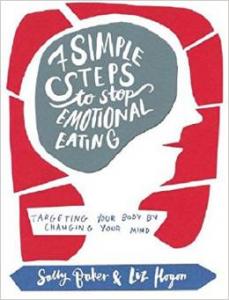Is emotional eating expanding your waistline but contracting your self-esteem? Following on from our feature on why you emotionally eat, we now bring you the small steps you can take right now to stop

tips have worked for Lily Allen
In their book Seven Simple Steps to Stop Emotional Eating: Targeting Your Body by Changing Your Mind, Sally Baker and Liz Hogon outline some effective ways to stop emotional eating. These include Emotional Freedom Technique (EFT) – which we’ll outline below – which have worked for celebrities including Lilly Allen.
There is a list of reasons emotional eating has crept into many of our daily lives, and is much more complex to end than any other type of compulsive behaviour. Resisting gambling, smoking, or alcohol can be helped therapeutically, but everyone needs to eat.
If losing weight were a matter of counting calories and exercising more, then everyone would easily achieve their goal weight and stay there. But this is not the case, and the simplification that people are emotionally eating because they are sad, greedy, or have no willpower ignores all the subconscious reasons that compel many to people to overeat.
Stopping emotional eating means achieving a healthy integration of food into your life, without the obsessive thinking and self-judgement.
- HIT THE PAUSE BUTTON
This technique is effective for times you are tempted to eat something you know you don’t need. More often than not we actually feel guilty after consuming that piece of food, the complete opposite to how satisfying those few moments were when it was in your mouth.
The next time you are resisting temptation, imagine you have a remote control for your life. Picture yourself there – and that biscuit, packet of crisps, or bar of chocolate you really want is in your hand. You’re feeling really weak with it there, so imagine hitting the pause button on the remote to freeze-frame your situation.

Now that you are on pause, physically spend the next few seconds running through the whole scenario mentally in your head, watching yourself eating whatever it is your tempted by and enjoying (or not!) a few quick seconds of gratification from it.
Then you need to fast-forward to five minutes after you’ve finished eating and think about how you’re feeling then and what you’re thinking. This will probably be the usual routine of feeling guilty, beating yourself up, and telling yourself you’re stupid for eating all that unnecessary food.
You are in control of your thoughts
Now that you’ve reminded yourself of those feelings, mentally rewind to the present and spend a few moments playing through the scenario once more, but this time add in the nice happy ending and see yourself recongnising that you’re not actually hungry and you don’t really need this food.
Fast forward five minutes later, and you are feeling strong, positive and proud of yourself. The reality is, the craving started in your mind, and you are in control of your thoughts.
Rewind to the present and consider the two possible outcomes. Feeling bad, or feeling good.
- RE-SET YOUR HUNGER DIAL
Hunger and the desire to eat are two different things that are very closely related. So often, compulsive eating and sugar cravings are nothing at all to do with being hungry, but are driven by emotional needs.
If you haven’t eaten for a few hours and your stomach feels empty, and is maybe even rumbling, then this could be real hunger. The best way to check is to have a glass of water. If you’re still feeling those empty feelings and rumblings in about 15 minutes, you’re definitely hungry.
If you have just eaten a meal and feel that you still want more, this is just a desire to eat, rather than actual hunger.
- IDENTIFY A CRAVING FOR WHAT IT IS
If you have a really strong urge to eat a particular thing and you also experience feelings of tension, then this is a craving. Cravings will go away as they are only thoughts we create ourselves. They can be demolished just as quickly as they can be given into.

Distract yourself. Go and get a glass of water. Play with the dog. Ring a friend. Remove yourself from the situation and you’ll find the craving passes. It is only a thought and thoughts can be changed and controlled.
If you see a craving as life-or-death, that needs to be dealt with immediately. Say to yourself: ‘This is just a craving, which is just a thought, that’s all. I don’t have to take any notice of it. If I concentrate on something else for just a few minutes I’ll forget about it and I’ll be really pleased with myself that I didn’t eat something that I didn’t really need.’
Some deep breathing is often helpful as well. You’ll feel more relaxed and the craving should have passed.
- KEEP A FOOD DIARY
It has been proven keeping a food diary can be a useful tool to help encourage a greater awareness, and even an enhanced sense of accountability. For some people, knowing they have decided to log everything they eat makes them less likely to binge or make poor food choices.
Take a look at the evidence you compile and you will soon be able to see a pattern in your eating
A food diary can be even more illuminating when it makes the connection between your hunger levels, and when you actually eat. You may be surprised that you are accustomed to grazing on food most of the day, and only ever reach low levels of hunger. For some people even a slight feeling of hunger can trigger strong emotions so they eat often, with only a small gap between meals.
Using a zero to 10 scale, where zero is not hungry at all and 10 is ravenously hungry, you can use your food diary to log how hungry you were when you ate.
Alternatively, you may see from your food diary that long stretches of time go by when you do not eat at all, so that by the time you do you are ravenous and feel completely out of control around food, leading to overeating or making poor food choices.
Using a zero to 10 scale, where zero is not hungry at all and 10 is ravenously hungry, you can use your food diary to log how hungry you were when you ate. Take a look at the evidence you compile and you will soon be able to see a pattern in your eating.
- OPTIMISE YOUR DIGESTION
It’s important to try and minimize unnecessary grazing and overeating. Try to make all your food from scratch instead of popping processed foods in the microwave. When you prepare food and cook it, all your senses are engaged, and they send messages to your brain that food is on its way. The brain in turn sends messages to your digestive system to stimulate production of enzymes necessary for optimum digestion.
A good habit to adopt while you consciously slow down your eating is to follow the mantra of ‘mouth full, hands empty’
If you usually eat lunch at your desk or in an office, make it a rule to eat somewhere else, or even better take a break away from the office to be in the open air if possible. If you do have to stay at your desk or work station to eat your lunch, turn off any screens to minimize distraction away from your food.
If you usually eat your meals at home on your lap while sitting on the sofa watching television, try eating at a table instead. If that’s not possible, at least for the duration of your meal turn off the distraction of the television and focus on what you are eating.

You may live with other family members where everyone is used to collecting their food from the kitchen at different times, and even eating it alone in their rooms. Instigate the eating of one meal a day, or even one meal a week, when all the family comes together to share the experience of eating together.
Try to chew each mouthful until the food is properly broken down before swallowing. Many people under-chew their food, swallowing pieces that are impossible to digest properly. Even if you are eating nutritionally-rich food, your body’s digestive system would struggle, and probably fail, to extract the full nutrient content from large chunks of food.
A good habit to adopt while you consciously slow down your eating is to follow the mantra of ‘mouth full, hands empty’. This means putting your cutlery down between mouthfuls and only picking it up again when you have chewed and swallowed the previous mouthful. This will make eating a meal a much slower experience, and you will find you will almost definitely be content to eat less than you usually would.
- DECLARE YOUR GOAL (even if only to yourself)
Anthony Robbins, a world-famous life coach, said any goal without a date is merely a dream. How often have you said ‘I’ll start the diet again in a couple of weeks’ time’ after the desire to lose weight is shrouded in disappointment or frustration after just one bad day?
Make a stand by writing a declaration of your desired goal to avoid inevitable repeated failure. Your goal needs to have a date by which you will achieve it. It can be a week, month, or a year. You can plot how you will look and feel and what you will wear on your next birthday, next Easter, or next Christmas. This process is called ‘scaffolding’ and it becomes the tangible evidence of your intention.
Attach old photographs of yourself when you were a size you were happier at. If those photos don’t exist, cut out pictures of people in magazines you admire. Strengthen your scaffolding by including cuttings from magazines of clothes, shoes and jewellery you will wear at your goal weight, or size. Is there a place you have always wanted to go holiday but can’t imagine yourself enjoying yourself by a poolside? Include pictures of those holiday destinations.

- WRITE A DREAM-COME-TRUE STATEMNT
When beginning a weight-loss process it’s important to allow yourself to imagine your situation from where you want to be, rather than where you are now. Building a dream-come true (DCT) protocol is a simple statement written in the first person and present tense, that represents your dream-come-true around your weight. It will read something like this:
‘I feel wondering at my goal weight’
‘I feel great now that I am a size 10’
‘I love weighing 140lbs’
Now build on your intention. Really feel your emotions swell around your DCT statement and how that would feel for you. Allow yourself to feel the emotional pull and power of having that be your reality. Add something like:
‘I am so proud of myself for reaching my goal weight’
‘I really enjoy taking care of myself and putting myself first’
‘I’m so enlightened at how successful and capable I am’
Next, add in some real physical benefits from achieving your DCT that really appeal to you now that you have achieved your weight loss:
‘I have so much energy’
I can walk for miles’
‘I can dance all evening long’
When you read back to yourself your three sentences you can see that you have begun to create a powerful intention that truly reflects what you want for yourself.
It’s important to allow yourself to imagine your situation from where you want to be, rather than where you are now
- ACCEPT EVERYTHING ABOUT YOURSELF
Self-acceptance doesn’t mean giving up. It is, however, a vital step in ending harsh, critical self-judgments and exhausting self-blame. Emotional eating isn’t about greed – or food! Otherwise dieting would have worked for you before. There are many things your emotional eating has stemmed from, such as learning from parents as a child, picking up bad habits as an adult, or a traumatic event. It’s important to end critical self-judgements, so that negative emotions that drove emotional eating can finally stop.
Send love and forgiveness from your future self back to you, the person beginning your weight-loss journey
Kathy Leach, in her book The Overweight Patient: A Psychological Approach to Understanding and Working with Obesity, says: ‘Ultimately, the person struggling with weight issues needs to establish a sense of self-worth, self-esteem, self-love and self-validation, and from this position can decide whether she/he will lose weight, or not’.
Write yourself a letter from the vantage point of having achieved your goal weight or size. In the letter tell yourself how proud you feel to have achieved your heart’s desire. Forgive yourself for not taking care of yourself in the past, and maybe discuss why this might have been and the obstacles you have faced. Reassure yourself of how much you value you and how you are determined to take better care of yourself in the future. Send love and forgiveness from your future self back to you, the person beginning your weight-loss journey.
- TRY EMOTIONAL FREEDOM TECHNIQUE (EFT)
If the above tips are yet to work for you, you may want to consider emotional freedom technique (EFT) – a tool that has been used for 20 years to help people effectively overcome emotional and physical issues. Often called ‘tapping’, it evolved from Chinese medicine, including acupuncture, and involves the tapping of two fingers, in a set sequence, on certain points of your face and body.
It may sound odd to newcomers, but EFT technique has been used to successfully treat fears, anxieties, phobias, post-traumatic stress disorder, and even physical issues such as migraines.
Here’s an EFT exercise to use when you have a food craving:
First, familiarise yourself with the EFT tapping points:
Eyebrow (EB)- At the inner end of one eyebrow, level with the top of your nose
Side of eye (SE)- Side of the eye, at the end of your eyebrow
Under eye (UE)– Under the eye, on the curved bone of your eye socket
Under nose (N)– In the dip under your nose
On chin (C)– In the dip under the bottom lip, on your chin
Collarbone (CB)– Around your collarbone (with a soft fist)
Ribcage (RIBS)– Fingers of both hands tapping on your ribcage at both sides of your body
Under arm (UA)– Flat hand at the side of your body, level with a woman’s bra strap or a mans nipple, about 4 inches down from under your arm
Wrists (W)- Tap the insides of your wrists together
Top of head (TH)- Tap around with a flat hand on top of your head
To prepare:
Turn off your phone, and familiarise yourself with the ‘tapping points’ above. Use what therapists call an ‘SUD rating’ to assess the intensity of your craving; zero mean no craving, and 10 would be the strongest.
The EFT set-up:
Once you have your SUD rating, what is called ‘set-up’ takes place while either rubbing on what is called the ‘sore spot’ (that is the place on your chest where you would pin a brooch).
The set-up focuses on the conscious mind on the task in hand. Really listen to what you are saying to yourself, and how it feels. As you rub, say to yourself:
‘Even though I need to comfort myself with food and I’m unable to stop, I completely and fully love and accept myself.’
‘Even though food is my comfort because I feel loved and warm when I’m eating, I completely and fully love and accept myself as I am now.’
‘Even though I use food to comfort myself when I’m stressed or feeling lost, I completely and fully love and accept myself without judgement.’
Now take three deep and gentle breaths.
Tapping:
Use 2 fingers of your dominant hand, to tap seven or eight times on each of the points in order.
As you touch each point, say these phrases:
EB: ‘I need that food so I can feel comforted.’
SE: ‘Part of me is longing for that comfort.
UE: ‘of a fully stomach’
N: ‘I’m feeling so hungry,
C: ‘so hungry for love.’
CB: ‘I’m drowning in stress
RIBS: ‘and don’t know how to feel okay.’
UA: ‘I want to let these cares and woes slide right off me.’
W: ‘I need that food so I can feel some relief.’
TH: ‘I’m feeling scared and overwhelmed.’
Pause and take one easy, deep breath.
EFT second round set-up:
Now, this is approximately what you should say out loud in preparation for the second round of tapping. Remember to tap on the ‘sore’ spot.
‘Even though i still have this need to comfort myself with food, I completely and fully love and accept myself.’
‘Even though I am using food to make myself feel better, even though it’s so bad for me, I completely and fully love and accept myself as I am now.’
‘Even though I’m trying to make myself feel okay by overeating, I’m willing to see that there may be better ways to deal with these emotions and I completely and fully love and accept myself without judgement.’
Second round of tapping:
EB: ‘I’m trying to wipe all these emotions away.’
SE: ‘I don’t have the support I’m longing for, so I’m using food to soothe myself.’
UE: ‘I’m trying to create the illusion of feeling full, and complete,
N: ‘but the truth is it’s not working very well for me.’
C: ‘It’s only creating more and more pain as I get fatter and fatter.’
CB: ‘What if I could start being more responsible and recognising that I can support myself on an empty stomach?’
RIBS: ‘Rather than just punishing my body with too much food,
UA: ‘I could choose to start making some changes now,
W: ‘even though it feels really scary.’
TH: ‘I can start to support myself now in positive and healthy ways.’
Pause and take one easy, deep breath. Assess your level of needing to comfort yourself with food and rate it again from zero to 10.
EFT third round set-up
‘Even though I’m still scared of letting go of this need to comfort myself with food, I completely and fully love and accept myself.’
‘Even though I am unsure if I can make the changes needed to move forward and be more responsible, I completely and fully love and accept myself as I am now.’
‘I want to release this habit of comforting myself with food and stop this self-sabotage, so I’m now starting to find healthy and positive ways of rewarding and comforting myself.’
Third round of tapping:
EB: ‘I now choose to forgive myself for all the damage I’ve done to my body.’
SE: ‘I’m choosing to find healthy and rewarding ways of soothing myself.’
UE: ‘I’m releasing this old, damaging need to comfort myself with food.’
N: ‘I was doing the best I could with the resources I had,
C: ‘but I can see now there are better ways of taking care of myself.’
CB: ‘I know now how to treat my body with love and kindness.’
RIBS: ‘I’m so much stronger and capable than I ever allowed myself to believe.’
UA: ‘I love this feeling of strength and joy,
W: ‘as I release all the old hurts and resentments from every cell of my body.’
TH: ‘I’m feeling so powerful as I make these wonderful changes.’
Pause and take one easy, deep breath.
Assess your level of need to comfort yourself with food and rate it from zero to 10. Has it gone up or down?
With each problem such as grazing, cravings, and self loathing are addressed, an EFT script has been designed with phrases and set-ups for each one. The aim is to repeat the different stages until you have successfully reduced the SUD rating to a low number.

£14.99 by Sally Baker and Liz Hogon is published by Hammersmith Books and available from Amazon
MORE: Emotional eating: 8 REAL reasons why you do it
Like this article? Sign up to our newsletter to get more articles like this delivered straight to your inbox.





















































